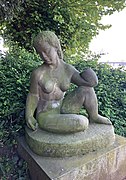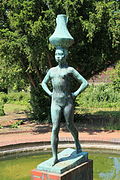Rhine garden

The Rheingärtchen is a ground floor and ornamental garden from the 1920s on the banks of the Rhine in Düsseldorf - Pempelfort .
history
The approximately 5000 square meter large Rhine garden lies above a sloping bank protection wall and extends along the facade of the Museum Kunstpalast on the Joseph-Beuys-Ufer. In the north it borders on the Rheinterrasse event building , in the south on the site of the Ulan monument by the sculptor Richard Langer . Like the Ulanendenkmal, an equestrian statue in memory of the Westphalian Uhlan Regiment No. 5 , which was once stationed in Düsseldorf , the Rhine garden was created in the wake of the GeSoLei , a trade fair that was held in Düsseldorf in 1926 and is considered the largest exhibition of the Weimar Republic .
- Sculptures by Bernhard Sopher
The draft Rhine little garden dated 26 February 1927, is the landscape architect Walter von Engelhardt back, and Johann Heinrich Kuchler (1888-1984) coincide and the Rheinpark Golzheim north conceived the Rhine terrace. In contrast to the sprawling lawns of the Rheinpark that the idea of public parks following form a multifunctional recreation and leisure space that should Rhine garden a "cozy home garden" or higher. As an intimate place of rest and leisure, it is surrounded by walls and fences, hedges, bushes and trees. Inside, it is divided into several sections along a main axis by a system of right-angled paths: in the north there is an area with an oval water basin in which Bernhard Soper's bronze sculpture The Nubian woman was installed in 1928 , in the middle there are lawns framed by geometric borders, where as There is an area with benches in front of the viewing platform facing the Rhine, in the south there is a small area with flower beds, on the south side of which a replica of Sophers ankle player made from Obernkirchen sandstone is set up by Hermann Isenmann . The first bronze production of the statue, created in 1926, has been in the Folkwang Museum in Essen since 1961 .
The geometry of the garden, which is designed to create a flat, rather sober effect, shows typical motifs of Engelhardt's work of this time and follows the design principles that Engelhardt implemented in the neighboring courtyard in 1925 . As a painting by the Düsseldorf genre and interior painter Alexander Bertrand from 1931 has come down to us, there were once white boxes with light pink hydrangeas in the Rhine garden, which were set up as potted plants at equal intervals to support the architectural effect of the garden.
The historic garden was placed under monument protection on March 30, 1993 . Due to the thunderstorm Ela , the Rhine garden lost a total of 17 trees in 2014. Historic shrubs, the fence and the historic path border were also affected by the storm. The replacement plantings began in spring 2016.
- Rhine garden, winter 2019
literature
- Wieland Koenig (Ed.): Düsseldorfer Gartenlust . Stadtmuseum Landeshauptstadt Düsseldorf, Düsseldorf 1987, p. 191.
- Barbara Klein: Lucky places on the Lower Rhine . Chapter 42: A Little Paradise. Rhine garden in Düsseldorf . Droste, Düsseldorf 2018, ISBN 978-3-7700-1567-2 .
Web links
- Rheingärtchen , website in the portal duesseldorf.de
- Rheingärtchen , 360 degree panorama in the portal stadtpanoramen.de
Individual evidence
- ↑ See catalog numbers 9.42 Rheinpark Düsseldorf and 9.46 Design for the garden on the Rheinterrasse in: Wieland Koenig (Ed.): Düsseldorfer Gartenlust . Stadtmuseum Landeshauptstadt Düsseldorf, Düsseldorf 1987, p. 190 f.
- ↑ Hans Maes (ed.), Alfons Houben et al: Düsseldorf in stone and bronze . Triltsch Verlag, Düsseldorf, 2nd edition, 1984, p. 83, ISBN 3-7998-0018-2 .
- ↑ See catalog no. 9.48 In the garden on the Rheinterrasse, 1931 in: Wieland Koenig (Ed.), P. 191.
- ↑ Rheingärtchen , website in the archive.ph portal , accessed on December 28, 2019.
Coordinates: 51 ° 14 ′ 6.9 ″ N , 6 ° 46 ′ 16.6 ″ E





